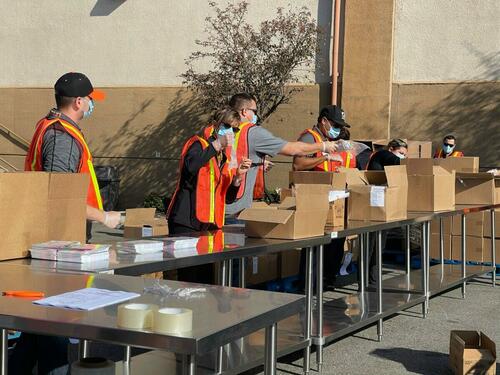“It Scares Me To Death”: More Ohio Families Turn To Food Banks Amid Cost-of-Living Crisis
Authored by Katabella Roberts via The Epoch Times (emphasis ours),

Food banks across Ohio have seen a surge in demand, with some running at double capacity amid increasing food insecurity prompted in part by an end to COVID-19 pandemic-era aid, according to experts.
The Mid-Ohio Food Collective, a food bank providing a free “grocery store experience” as well as nutritious meals to thousands of people is just one of many to see a surge in visitors amid a cost-of-living crisis.
According to its website, the food bank is already providing 170,000 meals each day for hungry people in central and eastern Ohio, but officials said that number has increased dramatically in the past year.
“Right now we’re running 47 percent higher in ’23 than we did, you know, a year ago,” Matt Habash, CEO of the Mid-Ohio Food Collective, told ABC News. “And I thought it would drop after the pandemic but I don’t think there’s any end in sight.”
“It scares me to death,” Habash added.
Habash said he believes part of the increased demand is owing to the phasing out of pandemic-era relief programs like stimulus checks, child tax credits, and extra food assistance, which have come to an end along with the national public health emergency.
Inflation has further added strain to household budgets.
While the U.S. annual inflation rate slowed to 4.9 percent in April, down from 5 percent in March, Bureau of Labor Statistics (BLS) data show, groceries are now 23 percent more expensive than before the start of the pandemic.

More Americans Facing Food Insecurity
Amid economic volatility, roughly 24.6 million adults didn’t have enough to eat in early April compared to 16.7 million the same month two years ago, the Census Bureau estimates.
The Ohio Association of Foodbanks is another organization that has seen a sharp increase in Americans experiencing food insecurity.
The association, which represents the state’s 12 Feeding America food banks and their 3,600-member hunger relief programs, said in a May 4 press release (pdf) that families across the state are becoming increasingly more vulnerable amid low wages and soaring inflation.
“They are worried about inflation and high costs, racking up credit card debt to afford basic needs, and turning to foodbanks at levels we did not see even at the height of the pandemic – at levels we have never experienced,” said Lisa Hamler-Fugitt, the association’s executive director.
“Just two months ago, pandemic-era Supplemental Nutrition Assistance Program (SNAP) benefit boosts ended. This change took $126 million per month in grocery-buying power out of the pockets of 1.5 million Ohioans,” Hamler-Fugitt said. “An average 3-person household lost about $200 per month in food assistance, overnight.”
The association added that it has spoken extensively with Ohioans about how the drastic drop in SNAP has impacted their mental and physical health.
Elsewhere, the Community Kitchen Columbus, which provides food to vulnerable members of the community, has seen demand for food soar so high that they are now looking to open another facility to cater to those in dire need.

Working Families Turn to Food Banks
“The misconception that a lot of people carry is that it’s only the homeless, that it’s always the people who are on drugs and alcohol [that visit the kitchen],” the organization’s president, MJ McCleskey, told ABC News.
“We do see a large population of that but there’s a lot of families, working families that are in need of food. They’re not homeless, they’re not couch surfing, they actually have a place,” she said.
It comes as a new study on food insecurity from the Center for Community Solutions found that roughly one in eight Ohioans are not always able to put food on the table for themselves and their families.
The findings are based on a compilation of surveys conducted over the last three years among just under 2,100 individuals across northeast Ohio.
It found that around 12 percent of respondents said they are unable to always afford food, mirroring similar research conducted by Feeding America on food insecurity in Ohio.
Additional research from the Center for Community Solutions found that 14.6 percent of older adults living in Cuyahoga County, Ohio, said they have had to spend less on things like medication or food to pay for housing costs. Another 24.5 percent of respondents in Lorain County said they believe someone in their household will likely need to turn to a food bank in the coming year.
“That somebody is struggling with food insecurity, we can’t tell by looking at someone. We can’t tell by knowing what their job is or what their situation is,” said Emily Muttillo, director of research for the Center for Community Solutions.
Muttillo noted that the situation for many Ohioans has likely worsened now that the emergency SNAP allotments are over.
“This is sort of a hidden struggle for many people and so it’s something that often goes overlooked,” she said.
Tyler Durden
Fri, 05/12/2023 – 17:00
Zero Hedge’s mission is to widen the scope of financial, economic and political information available to the professional investing public, to skeptically examine and, where necessary, attack the flaccid institution that financial journalism has become, to liberate oppressed knowledge, to provide analysis uninhibited by political constraint and to facilitate information’s unending quest for freedom. Visit https://www.zerohedge.com